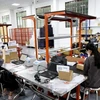The State Bank of Vietnam has removed the interest-rate cap on medium- to long-term loans, a move expected to end a two-year struggle by banks to maintain liquidity.
It is also expected to bring an end to unlawful lending practices that had banks charging above the interest-rate cap to improve their profit margins.
“Interest rates will increase but the increase will be controlled,” said national Monetary Policy Advisory Council member Cao Si Kiem. “Supply and demand for capital will meet each other at a point of real value and help create stable factors for credit growth.”
The change would also signal sound policy management and indicate a socialist-oriented market economy.
But removal of the cap also comes with worries about the higher cost for credit among enterprises.
As anonymous sources, who asked that their banks in Hanoi not be identified, told Vietnam News their contract interest for institutions now ranged from a yearly 14-18 percent, up 6 percentage points against Feb. 26 when it was 12 percent.
“An average lending interest of 17 percent coupled with price increases for gas, electricity, water and even wages, will challenge enterprises,” warned Asia Food Co general director Nguyen Van Tan.
“I’m not sure small and medium enterprises can bear such high prices for long,” he said.
ACB Computer Co general director Nguyen Ba Anh said; “We need capital so we will have a rare chance to negotiate interest with banks while ignoring how much it costs”.
“Personally I think that not many small and medium enterprises could raise new loans at new rates without having difficulties with production or business.”
Some economists were reminded of late 2007 when the price for goods escalated and the central bank had to apply the brakes to the money supply after inflation hit a 10-year high of 12.63 percent. So while approving the central bank’s decision, Cao Si Kiem warned of high pressure to use monetary policy to control inflation. The central bank’s decision allows negotiated interest rates for mid- to long -term business and investment loans an short- mid - to long- term loans for bank cards./.
It is also expected to bring an end to unlawful lending practices that had banks charging above the interest-rate cap to improve their profit margins.
“Interest rates will increase but the increase will be controlled,” said national Monetary Policy Advisory Council member Cao Si Kiem. “Supply and demand for capital will meet each other at a point of real value and help create stable factors for credit growth.”
The change would also signal sound policy management and indicate a socialist-oriented market economy.
But removal of the cap also comes with worries about the higher cost for credit among enterprises.
As anonymous sources, who asked that their banks in Hanoi not be identified, told Vietnam News their contract interest for institutions now ranged from a yearly 14-18 percent, up 6 percentage points against Feb. 26 when it was 12 percent.
“An average lending interest of 17 percent coupled with price increases for gas, electricity, water and even wages, will challenge enterprises,” warned Asia Food Co general director Nguyen Van Tan.
“I’m not sure small and medium enterprises can bear such high prices for long,” he said.
ACB Computer Co general director Nguyen Ba Anh said; “We need capital so we will have a rare chance to negotiate interest with banks while ignoring how much it costs”.
“Personally I think that not many small and medium enterprises could raise new loans at new rates without having difficulties with production or business.”
Some economists were reminded of late 2007 when the price for goods escalated and the central bank had to apply the brakes to the money supply after inflation hit a 10-year high of 12.63 percent. So while approving the central bank’s decision, Cao Si Kiem warned of high pressure to use monetary policy to control inflation. The central bank’s decision allows negotiated interest rates for mid- to long -term business and investment loans an short- mid - to long- term loans for bank cards./.



















